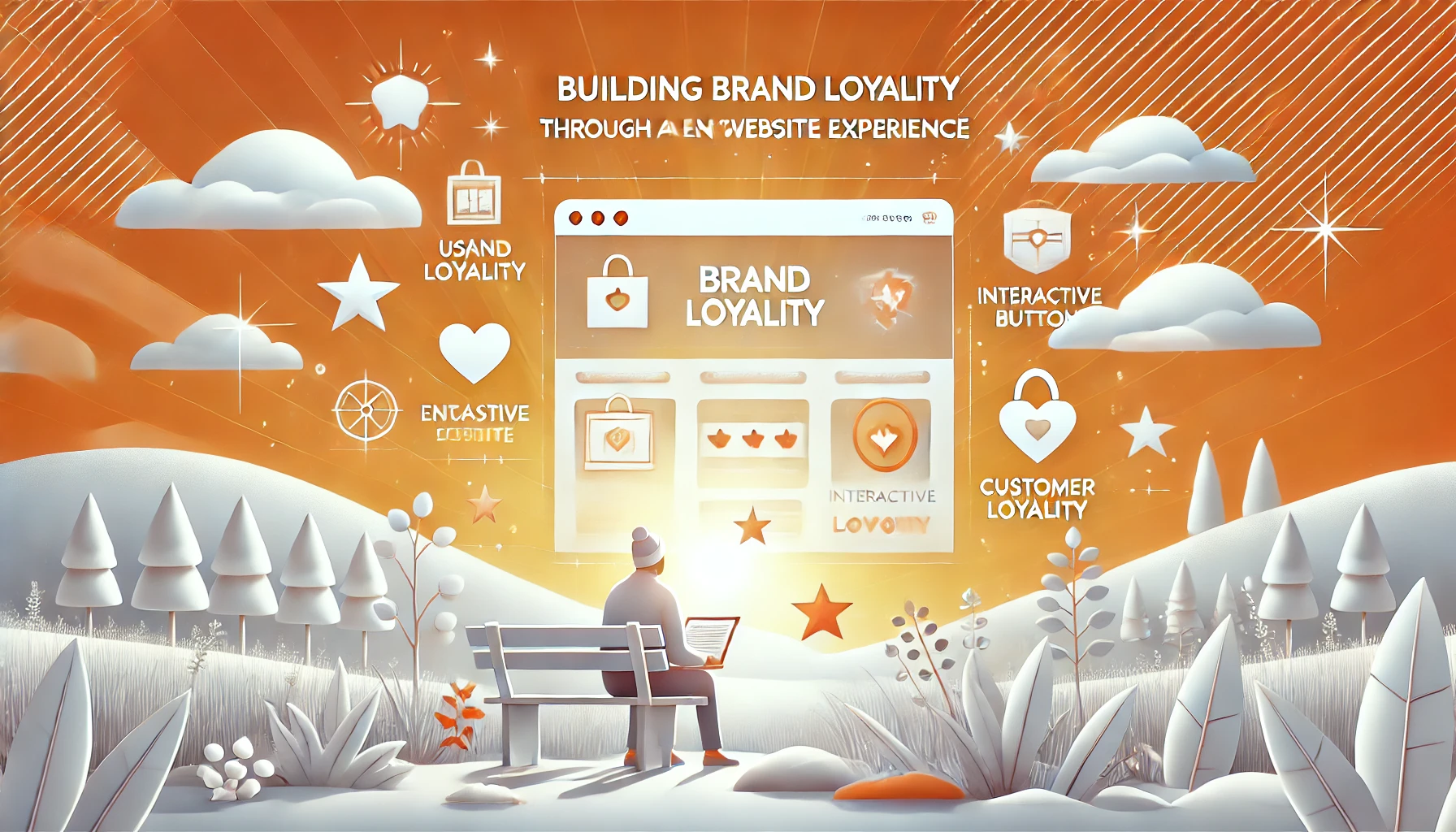Introduction
In today’s digital landscape, building brand loyalty has become a crucial element for long-term business success. A loyal customer base not only brings repeat business but also advocates for your brand, driving organic growth through positive word-of-mouth.
One of the most effective ways to cultivate this loyalty is through an engaging website experience. A well-crafted website is more than just a digital storefront; it serves as a 24/7 brand ambassador, shaping how customers perceive and interact with your business.
This is where a professional website designing company plays a vital role. With a focus on innovative website design and seamless web development, businesses can create an online presence that keeps customers coming back.
The significance of a website in shaping customer perceptions cannot be overstated. It is often the first point of contact between a brand and its potential customers.
As such, it must leave a lasting impression. A positive website experience can lead to increased customer satisfaction, greater engagement, and ultimately, loyalty.
When customers find a website easy to use, aesthetically pleasing, and rich in valuable content, they are more likely to develop a sense of connection to the brand.
This emotional connection is key to building loyalty, as customers are more likely to return to brands that resonate with them on a personal level.
Moreover, the digital marketplace is highly competitive, with countless brands vying for the attention of consumers. A unique and engaging website can differentiate a brand from its competitors.
Through strategic design and development, businesses can effectively communicate their unique selling propositions and values, fostering a strong brand identity.
This process involves not just creating a visually appealing website but also ensuring that it functions well and meets the needs of users.
In this article, we will explore how an engaging website experience contributes to brand loyalty. We will delve into the importance of website design, user experience, and the various elements that can enhance engagement.
Additionally, we will discuss the role of SEO in increasing visibility and trust, and how businesses can implement best practices for web development. By understanding and applying these principles, companies can build a loyal customer base that drives sustainable growth.
Understanding Brand Loyalty
Brand loyalty refers to the consistent preference and positive emotional connection customers have with a brand, often resulting in repeat purchases and a reluctance to switch to competitors.
Achieving brand loyalty is no small feat; it requires a holistic approach to customer experience, especially online. A website that is easy to navigate, visually appealing, and provides valuable content can significantly influence customer perception and loyalty.
A skilled website designing company understands how to align the visual and functional elements of a site to foster trust and engagement, turning visitors into long-term advocates.
At its core, brand loyalty is about trust. When customers trust a brand, they are more likely to choose it over others, even in the face of better offers from competitors.
Trust is built over time, and a website plays a crucial role in this process. It serves as a platform for brands to communicate their values, missions, and commitments to their customers.
A well-designed website can effectively convey professionalism, reliability, and authenticity, which are essential attributes for fostering trust.
Moreover, customer engagement is directly tied to brand loyalty. Engaged customers are more likely to return and recommend a brand to others. This is where the user experience (UX) of a website comes into play.
A positive UX not only enhances customer satisfaction but also encourages users to explore the site further, leading to increased interactions with the brand. This engagement can be further enhanced through personalized experiences, where the website adapts to individual user preferences, making customers feel valued and understood.
In addition, brand loyalty is closely linked to emotional connections. When customers feel a sense of belonging or alignment with a brand’s values, they are more likely to remain loyal.
This emotional aspect can be cultivated through storytelling, visuals, and community engagement on the website. A website designing company can assist in creating an emotional narrative that resonates with the target audience, ultimately fostering deeper connections.
In conclusion, understanding brand loyalty is essential for any business aiming to thrive in a competitive marketplace.
By focusing on building trust and emotional connections through an engaging website experience, companies can cultivate a loyal customer base that not only drives sales but also advocates for the brand.
The Role of Website Design in Building Brand Loyalty
Website design is a crucial factor in establishing and nurturing brand loyalty. The aesthetic appeal of a site plays a significant role in creating first impressions. Research shows that users form opinions about a website in less than a second.
A professional website designing company ensures that your site has an appealing color scheme, appropriate typography, and high-quality images, all contributing to a positive first impression.
The initial experience a visitor has on your website sets the tone for their perception of your brand. A visually appealing site can evoke positive emotions, encouraging users to stay longer and explore more.
In contrast, a poorly designed website can lead to immediate disengagement and a negative perception of the brand. Therefore, investing in high-quality design is essential for fostering brand loyalty.
Beyond aesthetics, the usability of a website is paramount. A well-designed site should be intuitive, allowing users to navigate easily without confusion.
An effective navigation structure enhances the overall user experience, making it easy for visitors to find the information they need. When users encounter obstacles or frustrations while navigating a site, they are more likely to abandon it and seek alternatives, leading to lost potential customers.
A website designing company can create a logical flow and organized categories to facilitate easy navigation.
Moreover, a professional website design takes into account the importance of responsiveness. With the increasing use of mobile devices for browsing, having a mobile-responsive website is no longer optional.
A site that provides a seamless experience across devices fosters brand loyalty by ensuring that customers can access your content anytime, anywhere.
A responsive design adapts layouts to fit screens of all sizes without sacrificing usability, creating a consistent experience regardless of the device used.
Another crucial aspect of website design is the integration of calls to action (CTAs). Effective CTAs guide users towards desired actions, whether it’s making a purchase, signing up for a newsletter, or exploring additional content.
Strategically placed CTAs can significantly influence user behavior and encourage engagement, contributing to a stronger connection with the brand.
In summary, the role of website design in building brand loyalty cannot be underestimated. A visually appealing, user-friendly, and responsive website creates a positive experience that keeps customers engaged.
By investing in professional website design, businesses can establish a strong brand identity and foster lasting loyalty among their customers.
Engaging Website Elements That Drive Brand Loyalty
To build brand loyalty, your website must offer engaging elements that captivate visitors and encourage interaction. Here are several components that can enhance user experience and promote brand loyalty:
1. Use of Visuals, Videos, and Interactive Elements
Incorporating high-quality visuals and videos can make your website more engaging. Research shows that visual content is more likely to be shared and remembered than text alone.
Engaging visuals can help convey your brand’s message more effectively, making it easier for users to connect with your offerings. High-resolution images of products, behind-the-scenes videos, and infographics can enhance storytelling and create a richer experience for visitors.
Interactive elements, such as quizzes, polls, and user-generated content, can also enhance user participation. These features not only keep users interested but also encourage them to interact with the brand on a deeper level.
For instance, a fashion retailer might include a style quiz that recommends outfits based on user preferences, making the shopping experience more personalized and enjoyable. This level of engagement fosters a sense of connection and loyalty to the brand.
2. Personalized Content and Recommendations
Personalization is key in today’s competitive market. Tailoring content and recommendations based on user behavior can significantly improve engagement.
A website designing company can implement algorithms to analyze user data and present relevant products or content, making each visit unique and tailored to the individual user’s preferences.
For example, e-commerce websites often use personalized product recommendations based on previous purchases or browsing behavior. This not only enhances the user experience but also increases the likelihood of conversions.
When users feel that a brand understands their needs and preferences, they are more likely to develop loyalty and return for future purchases.
3. Incorporating Storytelling Through Design
Storytelling can evoke emotions and connect with users on a deeper level. A website that tells a story through its design—using imagery, text, and layout—can create an emotional bond with visitors.
This connection fosters brand loyalty as customers feel more aligned with your brand’s values and mission.
For instance, a nonprofit organization might use its website to share stories of individuals impacted by its work, along with compelling visuals that highlight its mission.
This storytelling approach not only engages visitors but also encourages them to support the cause and remain loyal advocates for the brand.
4. Case Study: A Website Designing Company’s Approach to Integrating Engaging Content
Consider a case study of a website designing company that revamped an e-commerce site to improve engagement.
By incorporating dynamic content such as video testimonials and interactive product displays, they increased average session duration by 40% and boosted conversion rates by 25%.
The project involved a comprehensive analysis of user behavior and preferences, leading to the implementation of interactive features like a virtual try-on tool for clothing.
This innovation allowed users to see how garments would look on them, significantly enhancing the shopping experience. Additionally, the website featured customer testimonials prominently, reinforcing trust and encouraging potential buyers to make purchases.
This example underscores the impact of engaging design elements in building brand loyalty. By leveraging visuals, personalization, and storytelling, businesses can create an immersive website experience that resonates with customers and encourages lasting loyalty.
Web Development Best Practices for Brand Loyalty
Beyond the visual appeal, the technical aspects of web development are equally important in fostering brand loyalty. Here are some best practices that ensure your website operates smoothly:
1. Speed Optimization: How Fast Load Times Enhance User Experience
Website speed is a critical factor in user satisfaction. Studies indicate that users expect pages to load within two seconds, and any delay can lead to higher bounce rates.
A slow-loading website not only frustrates users but can also negatively impact your search engine rankings. To ensure optimal performance, businesses should prioritize speed optimization strategies.
This includes compressing images, minimizing code, leveraging browser caching, and utilizing content delivery networks (CDNs).
A professional web development team can implement these strategies to enhance site speed, ensuring that users enjoy a seamless browsing experience.
When customers encounter a fast, responsive website, they are more likely to explore further, increasing their chances of making a purchase and returning in the future.
2. Mobile Responsiveness: Catering to Users on Different Devices
With the rise of mobile browsing, having a mobile-responsive website is no longer optional. Mobile responsiveness ensures that your site functions well on various devices, providing a consistent experience for users.
Google has made mobile-friendliness a ranking factor, meaning that a non-responsive site can hurt your visibility in search results.
A responsive design adapts layouts to fit screens of all sizes, ensuring that users can navigate effortlessly, regardless of whether they are on a desktop, tablet, or smartphone.
By prioritizing mobile responsiveness, businesses can cater to a broader audience, ultimately fostering brand loyalty among users who appreciate the flexibility of accessing content on their preferred devices.
3. Security Features: Building Trust with Customers
In today’s digital world, security is paramount. Customers want assurance that their personal information is safe when they visit a website.
Implementing security features, such as SSL certificates, secure payment gateways, and regular security audits, is essential for building trust.
A professional web development team can help integrate these security measures, ensuring that users feel safe while browsing and making transactions on your site.
When customers trust that their information is protected, they are more likely to engage with your brand, leading to increased loyalty.
4. The Importance of Regular Updates and Maintenance
Web development is an ongoing process. Regular updates and maintenance ensure that your website remains functional, secure, and relevant. This includes updating content, fixing bugs, and optimizing performance.
A well-maintained website enhances user experience, as visitors are less likely to encounter errors or outdated information.
Engaging a reliable web development partner can help businesses stay ahead of potential issues and maintain a high-quality online presence.
Regular maintenance demonstrates to customers that you value their experience and are committed to providing the best service possible, further strengthening brand loyalty.
The Impact of SEO on Brand Loyalty
Search engine optimization (SEO) plays a pivotal role in enhancing brand loyalty by increasing visibility and driving organic traffic. When users can easily find your website through search engines, it not only increases engagement but also establishes credibility and trust in your brand.
1. Enhancing Visibility Through Quality Content
Creating high-quality, relevant content is at the heart of effective SEO. When users find valuable information on your website, they are more likely to stay, engage, and return.
Regularly updating your blog with informative articles, guides, and resources positions your brand as an authority in your industry.
A website designing company can help you create a content strategy that aligns with your target audience’s interests, ensuring that your website consistently offers fresh and relevant content.
This approach not only attracts new visitors but also fosters loyalty among existing customers who appreciate your brand’s commitment to providing valuable resources.
2. Building Trust Through Transparent SEO Practices
Transparency in your SEO practices builds trust with customers. Avoid using deceptive tactics such as keyword stuffing or black-hat SEO strategies, as these can damage your reputation and lead to penalties from search engines.
Instead, focus on ethical, white-hat SEO techniques that prioritize user experience and long-term success.
By being transparent about your SEO efforts and sharing insights into how your website is optimized for search engines, you can foster a sense of trust with your audience.
Customers appreciate brands that are open about their practices, and this trust can translate into loyalty.
3. The Role of Local SEO in Fostering Community Loyalty
For businesses with a physical presence, local SEO is crucial. Optimizing your website for local searches ensures that your brand appears in relevant searches within your geographical area.
This is especially important for small businesses looking to build a loyal customer base in their community.
A website designing company can assist in optimizing your site for local SEO by incorporating location-specific keywords, creating local business listings, and encouraging customer reviews.
By fostering community engagement through local SEO efforts, businesses can build loyalty among local customers who appreciate supporting neighborhood brands.
4. Measuring SEO Success and Its Impact on Brand Loyalty
Tracking the success of your SEO efforts is essential for understanding their impact on brand loyalty. Utilize analytics tools to monitor traffic, engagement metrics, and conversion rates.
Understanding which strategies resonate with your audience allows you to refine your approach and enhance user experience.
By consistently measuring and adjusting your SEO practices, you can create a website that not only attracts visitors but also retains them as loyal customers.
This ongoing commitment to optimization and user satisfaction reinforces your brand’s reputation and fosters lasting loyalty.
The Importance of Building Trust Through Your Website
Trust is the foundation of brand loyalty. Customers are more likely to engage with brands that are authentic and transparent about their practices. Here are several strategies for building trust through your website:
1. Showcasing Reviews and Testimonials on Your Website
Displaying customer reviews and testimonials builds credibility and reassures potential customers about the quality of your products or services.
A website designing company can integrate these elements seamlessly into your site to enhance trust. Incorporating user-generated content, such as customer photos or videos, further humanizes your brand and fosters a sense of community.
Consider implementing a dedicated testimonials page or highlighting positive reviews on product pages. By showcasing real customer experiences, you provide social proof that can influence potential buyers and encourage them to make a purchase.
2. Transparency in Privacy Policies and Terms
Clearly communicating your privacy policies and terms of service helps build trust with users. Ensuring that customers know how their data is used and protected fosters confidence in your brand.
A transparent approach to data handling not only complies with regulations but also demonstrates your commitment to protecting customer information.
A website designing company can help craft easy-to-understand privacy policies and terms that are accessible on your site. Including clear language about data collection, usage, and security measures reassures customers that their information is safe.
3. The Role of Web Development in Creating Secure and Trustworthy Online Experiences
Investing in secure web development practices, such as implementing HTTPS and regular security audits, protects customer data and builds trust. When users feel secure while browsing your site, they are more likely to engage and make purchases.
Additionally, prominently displaying security badges and certifications can further enhance user confidence.
A professional web development company can ensure that your website meets industry standards for security, reinforcing your brand’s commitment to customer safety.
Case Study: A Successful Website Transformation
To illustrate the impact of an engaging website experience on brand loyalty, consider the transformation of a retail business that revamped its website with the help of a website designing company.
1. Real-World Example of a Brand That Built Loyalty Through a Revamped Website
After facing declining sales, a local clothing retailer partnered with a website designing company to redesign their online store.
By focusing on user experience, implementing engaging visuals, and optimizing for mobile devices, they created an appealing online environment.
The redesign included features such as personalized product recommendations, user-friendly navigation, and high-quality images showcasing their clothing line. This transformation resulted in a significant increase in website traffic and customer engagement.
2. The Role of a Website Designing Company in the Transformation
The website designing company utilized user feedback to enhance navigation and integrated a personalized shopping experience based on user preferences. They also implemented a blog featuring style tips, fostering community engagement.
By prioritizing customer feedback throughout the redesign process, the company ensured that the final product met the needs and expectations of their target audience.
This focus on user experience not only increased satisfaction but also encouraged repeat visits and purchases.
3. Key Takeaways for Businesses Aiming to Replicate Success
The success of this transformation highlights the importance of investing in professional website design and web development. By prioritizing user experience and engagement, businesses can significantly boost brand loyalty and drive sales.
Key takeaways include the value of personalization, the importance of mobile optimization, and the impact of engaging content.
By following these principles, businesses can create a website that not only attracts customers but also keeps them coming back.
Future Trends in Website Design and Web Development
As technology evolves, so do the trends in website design and web development. Staying ahead of these trends is essential for maintaining brand loyalty. Here are some key trends to watch:
1. The Role of AI and Machine Learning in Personalization
Artificial Intelligence (AI) and machine learning can enhance personalization on websites. By analyzing user behavior, these technologies can tailor content and product recommendations, creating a more engaging experience that fosters loyalty.
For instance, AI-powered chatbots can provide instant support, guiding users through their shopping experience and addressing concerns in real-time. These tools not only improve customer satisfaction but also enhance engagement, making users feel valued and understood.
2. Chatbots and Their Role in Enhancing Customer Support
Implementing chatbots on your website can provide instant support to users, improving customer satisfaction. These AI-driven tools can answer common queries, guiding users through their shopping experience and addressing concerns in real-time.
Chatbots can significantly reduce response times and offer 24/7 support, making it easier for customers to engage with your brand. As technology continues to advance, incorporating chatbots into your website will become increasingly important for fostering brand loyalty.
3. Trends Like Dark Mode and Minimalist Design
Dark mode and minimalist design are gaining popularity among users. These trends prioritize readability and user comfort, creating a visually appealing experience that resonates with modern consumers.
Adopting these design elements can enhance user engagement and create a memorable online experience. By staying attuned to evolving design preferences, businesses can better cater to their audience’s expectations and foster loyalty.
4. Voice Search Optimization for Enhanced User Experience
As voice search becomes more prevalent, optimizing your website for this technology is crucial. Ensuring that your content is voice-search friendly can enhance user experience and improve SEO performance.
By incorporating natural language processing (NLP) techniques and structuring content for voice queries, businesses can cater to the growing number of users relying on voice-activated devices.
This approach not only improves accessibility but also positions your brand as innovative and customer-centric.
Conclusion: The Interplay Between Web Development, SEO, and Brand Loyalty
In conclusion, investing in effective web development and SEO strategies is essential for building brand loyalty. By creating an engaging website experience, enhancing visibility through SEO, and establishing trust with customers, businesses can foster lasting relationships with their audience.
Ultimately, the goal is to provide an exceptional user experience that keeps customers coming back. As the digital landscape continues to evolve, prioritizing web development and SEO will remain critical in nurturing brand loyalty and driving business success.





